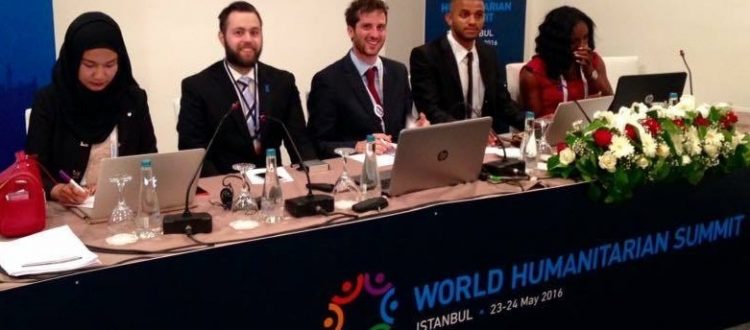Scaling up our commitment for humanity – voices from the World Humanitarian Summit
The World Humanitarian Summit in May 2016 emphasized the severity of some of the most important challenges currently facing humanity and declared the necessity to “bring humanitarian, development and peacebuilding efforts together”.
| Suggested Reading | Conflict Background | GCCT |
The World Humanitarian Summit in May 2016 emphasized the severity of some of the most important challenges currently facing humanity and declared the necessity to “bring humanitarian, development and peacebuilding efforts together”.
The themes at the core of the summit are very important to the work of UNOY Peacebuilders as a network of youth-led peacebuilding organisations. The network was represented by a group of young activists: Achaleke Christian Leke, Anca Gliga, Diego Cimino, Martine Kessy Ekomo, Marouane Bakit, Patrick Enwerem and Rashid Zuberu.
Asked about the achievements of the Summit, Patrick highlights the high level of commitment along the 5 Core Responsibilities envisaged by Ban Ki-moon in his “Agenda for Humanity”: “the stakeholders recognised global challenges as a shared responsibility, committed to an enhanced compliance with International Humanitarian and Human Rights Law, and affirmed their responsibility to prevent and end conflicts upholding the essential participation of youth”.
 The ‘Compact for Young People in Humanitarian Action’, signed by over 30 UN Agencies and NGOs including UNOY Peacebuilders was the most relevant formal achievement of the Summit for youth. Building on UN Security Council Resolution 2250 on Youth, Peace and Security and on the Doha Youth Declaration on Reshaping the Humanitarian Agenda, it recognized the strengths of youth in the response to humanitarian situations as well as the responsibility to protect young people’s rights.
The ‘Compact for Young People in Humanitarian Action’, signed by over 30 UN Agencies and NGOs including UNOY Peacebuilders was the most relevant formal achievement of the Summit for youth. Building on UN Security Council Resolution 2250 on Youth, Peace and Security and on the Doha Youth Declaration on Reshaping the Humanitarian Agenda, it recognized the strengths of youth in the response to humanitarian situations as well as the responsibility to protect young people’s rights.
In addition to the formal conclusions of the Summit, the UNOY Peacebuilders representatives underline the positive effects descending from the gathering of a great variety of stakeholders engaged in the humanitarian field. The Summit, bringing together different perspectives to look at the challenges arising from humanitarian situations, worked as a platform for sharing points of view, experiences, knowledge and strategies, for fostering the enhancement of previously established partnerships and the creation of new connections.
 Diego highlights this very aspect of the Summit affirming that “the main outcome is the momentum that it has created among the actors of the humanitarian field, which gathered for the first time all together to draw a common direction and a shared responsibility for addressing the huge humanitarian crisis all around the world. If they will be able to capitalize such a momentum, the Summit could be considered a success”.
Diego highlights this very aspect of the Summit affirming that “the main outcome is the momentum that it has created among the actors of the humanitarian field, which gathered for the first time all together to draw a common direction and a shared responsibility for addressing the huge humanitarian crisis all around the world. If they will be able to capitalize such a momentum, the Summit could be considered a success”.
It is however necessary for us to remain pragmatic on the achievements of the World Humanitarian Summit. Where do we stand at in facing the challenges arising from the engagement in humanitarian action after the Summit? Notwithstanding the positive recognition of the role of youth in humanitarian situations and the sincere commitment of the diverse range of stakeholders present, the absence of key governments remains a reason of concern. In addition, the true challenge starts now that the spotlights of the Summit are turned off and consists in living up to the promises made.
Looking at the unique and unprecedented level of cooperation on humanitarian issues reached at the Summit, and at the positive engagement of the representatives of the civil society, we remain optimistic on humanity’s joint capabilities to increase its commitment to addressing the major humanitarian challenges facing us. In addition, as Anca reports from the signing ceremony of the Compact for Young People, one of the key messages of the Summit is that in national and international fora “we are finally beginning to talk to youth, not only about youth”.
UNOY Peacebuilders are a member of the Global Coalition for Conflict Transformation, comprised of organizations committed to upholding and implementing the principles of conflict transformation.
This article was originally published on UNOY Peacebuilders’ website and is available by clicking here. The views expressed in this article do not necessarily reflect the views of TransConflict.




















Scaling up our commitment for humanity – voices from the World Humanitarian Summit – TransConflict https://t.co/s4f7p8QZHO
RT @TransConflict: Scaling up our commitment for #humanity – voices from the World #Humanitarian Summit: The World… https://t.co/xfVqSVxZ…
RT @ena_ssudan: Scaling up our commitment for humanity – voices from the World Humanitarian Summit – TransConflict https://t.co/s4f7p8QZHO
RT @ena_ssudan: Scaling up our commitment for humanity – voices from the World Humanitarian Summit – TransConflict https://t.co/s4f7p8QZHO
RT @TransConflict: Scaling up our commitment for #humanity – voices from the World #Humanitarian Summit: The World… https://t.co/xfVqSVxZ…